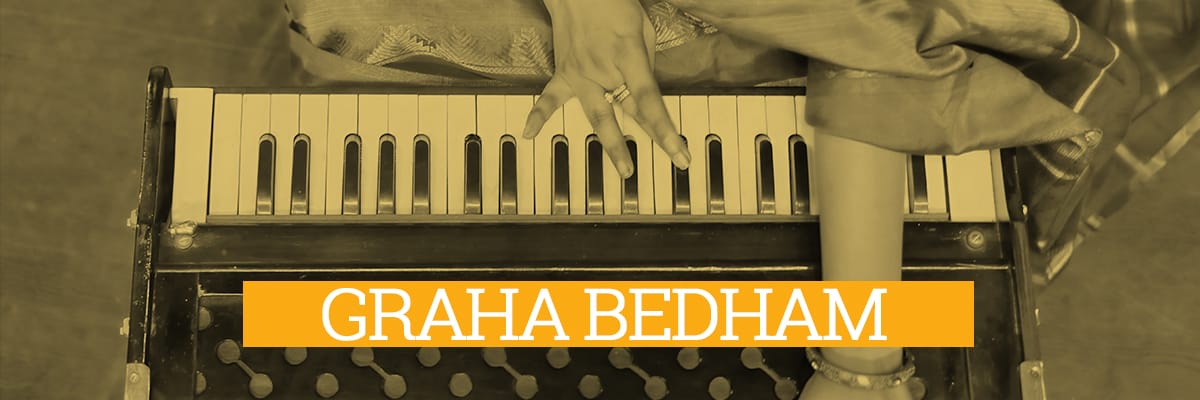
Graha Bedam is the favourite topic of most of the musicians / artist to prove their talent in kacheri’s. Graha Bedham in Carnatic music is the process of shifting the (śhruthi) to another note in the rāgam and arriving at a different rāgam. Bedham refers to seeing the difference. Its equivalent in Hindustani classical music is called a murchhana. Expressed in Western music theory terms, this is the process of arriving at a different scale by shifting to another mode in the key.
Graha literally means position and Bhedam means change. Since the position of the śhruthi is changed (pitch of the base note or drone), it is also sometimes called Swara Bhedam or Śhruthi Bhedam.
Modal shift of the Tonic note to higher notes of an rāgam, while retaining the note's positions (swara sthānas – sthāna means position/ pitch), results in different rāgams. This is called Graha Bhedam.
A simple practical demonstration of Graha Bhedam can be taken up by playing the structure of an rāgam with the drone set to SA (Shadjamam). Then if we keep playing the same keys/ notes, while shifting the drone to another note in the rāgam, to form the new śruti/ tonic note, the result is a different rāgam.
I’m taking raga Shankarabharanam's notes, it yields 5 other major Melakarta rāgams, namely, Kalyani, Hanumatodi, Natabhairavi, Kharaharapriya and Harikambhoji. Shankarabharanam raga is the main key raga taken in Western music named as “Major Scale”
Major tunes which we hear in most of the rhymes, lullabies are set to this major raga.
- G# is the scale using as the base for Shankarabharanam is chosen for above illustration only for convenience, as Carnatic music does not enforce strict frequency/pitch structure. The Shadjam (S) is fixed by the artist as per the vocal range or the instrument's tonic note. All the other swarams are relative to this Shadjam, falling into a Geometric progression - like frequency pattern.
- The 6th Graha Bhedam of Shankarabharanam has both Madhyamams (Ma) and no Panchamam (Pa) and hence will not be considered a valid Melakarta (ragam having all 7 swarams and only 1 of each). This is only a classification issue with respect to Melakarta, while this structure could be theoretically used well to create good music.
- Graha Bhedam can be applied on most Melakarta rāgams to yield other Melakarta rāgams (16 of the 72 do not yield any valid Melakarta scale).
- When applying such modal shift of tonic note, some results are not valid Melakarta rāgams (rules of the definition of Melakarta are violated).
- Example scenarios are missing Panchamam (Pa) or two of particular note (Rishabham (Ri), Gandharam (Ga), Madhyamam (Ma), Dhaivatam (Da) or Nishadam (Ni)).
- Graha bhedam, or sruthi bhedam is an interesting concept of Carnatic music. In western classical music, there is a concept of modes. Both these are same concepts.
- Essentially, graha bhedam means to change the base frequency while keeping the frequencies of other notes the same.
- Let me explain this taking Shankarabharanam as an example. We know that the notes of Shankarabharanam are:
S R2 G3 M1 P D2 N3 S
- Now, when you do a graha bhedam, you keep these particular frequencies (notes) the same, but you change the home frequency to let's say R2.
- Now, since we have changed the base frequency, we have to call the new base frequency as S.
- But since the other frequency positions remain the same, we need to see the intervals between these frequencies.
- Between R2 and G3, there is one semitone. This means that if you keep R2 as the base frequency and call it S, the next note and S also should have one semitone between them, which will yield R2. Similarly between G3 and M1, M1 is the next semitone after G3.
- So, in our newly formed scale, the next note should be the next semitone to R2, which is G2. Continuing in this fashion, keeping the inter-note intervals of Shankarabharanam the same and shifting the base pitch to R2, we get
S R2 G2 M1 P D2 N2 S
- Which is nothing other than kharaharapriya? It should be noted that after the 7th note, we move to the next S octave wise to yield the subsequent notes in graha bhedam.
- In the same manner, Shankarabharanam on graha bhedam gives Todi, Kalyani, Harikamboji, and Natabhairavi on shifting the base frequency to G3, M1, P, and D2 respectively.
- In western classical music, the equivalent to Shankarabharanam is the major scale.
- Mohanam - S R2 G3 P D2 S on graha bhedam yields madhyamavati, hindolam, shuddha saveri and shuddha dhanyasi respectively.
- Kamavardhani( or Pantuvarali) - S R1 G3 M2 P D1 N3 S upon graha bhedam in the last note, N3 gives kanakangi, the first melakarta raga.
- Hamsadhwani - S R2 G3 P N3 S on graha bhedam on P gives nagaswaravali.
- When it comes to the graha bedham concept an artist can use their own creativity. Mostly Kalyani to Shankarabharanam, vice versa.
- Make a note to be centralized. From their they can be used in Raga Alapana. In swara kalpana it is something different which has to be more calculative in every aspect.
- For Kacheri’s Violin is the key roal for supporting vocals. So in raga alapana part will be more convenient. But creativity, calculations are more applicable technically. A musician’s brain will be more enthusiastic.
- We can see the interesting concepts in which music composers are mixing different ragas as smoothening tunes which Shruthi bedam concept is the high motivation to them.
Some of the examples which we can make combinations are
- Shankarabharanam & Kalyani
- Hamsanandhi & Mohanam ragam
- Mohanam & Madyamavathy
- Mohanam & Hindolam
- Mohanam & Shudhasaveri
- Mohanam & Shuddhadhanyasi
- Pantuvaralai & Kanakangi
- Hamsadwani & Nagasvaravali
- Simhendra Madhyamam & Suddha Dhanyasi
- Sarasangi & Dharmavathi
- Keeravani & Vakulabharanam